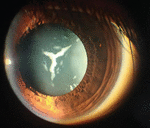Introduction
Pediatric has an estimated prevalence of 3–6 per 10,000 live births. It is one of the major causes of preventable blindness in childhood. Approximately 200,000 children worldwide are affected by this disease (1).
Case
A 15-year-old female visited us for a routine ocular checkup. Her best-corrected visual acuity was 6/6 in the right eye and 6/12 in the left eye. There was no significant perinatal, medical, surgical, family, traumatic, or drug abuse history. On slit-lamp examination, there was the presence of Y-shaped lenticular opacities that followed the sutures of the lens nucleus in the left eye (Figure 1). The rest of her ocular examination was within normal limits. Her pediatric examination did not reveal any systemic disease.
Discussion
Pediatric cataracts are called congenital if they are present within the first year of life and called developmental if present after infancy (2). A sutural cataract is an uncommon lenticular opacity that is usually congenital and hereditary with X-linked transmission (3). It is in the form of a “Y” following the sutures of the lens. This cataract does not cause a significant decrease in vision and neither does it progress (4). They are often accidental findings on routine ocular examination. They have been described in female carriers of the Nance-Horan syndrome, with affected males having a visually significant cataract (5).
Source of support-none
The paper being submitted has not been published, simultaneously submitted, or already accepted for publication elsewhere.
Financial disclosure(s)
The authors have no proprietary or commercial interest in any material discussed in this article.
References
1. Holmes J, Leske D, Burke J, Hodge D. Birth prevalence of visually significant infantile cataract in a defined US population. Ophthalmic Epidemiol. (2003) 10:67–74.
2. Medsinge A, Nischal K. Pediatric cataract: challenges and future directions. Clin Ophthalmol. (2015) 9:77–90.
